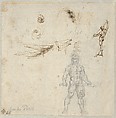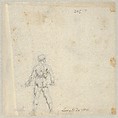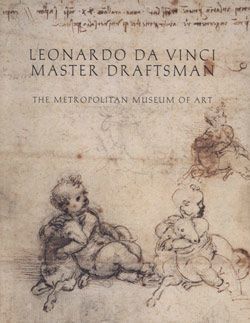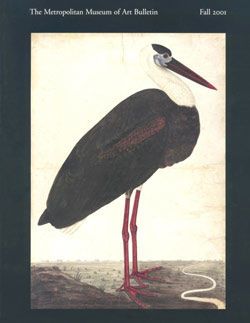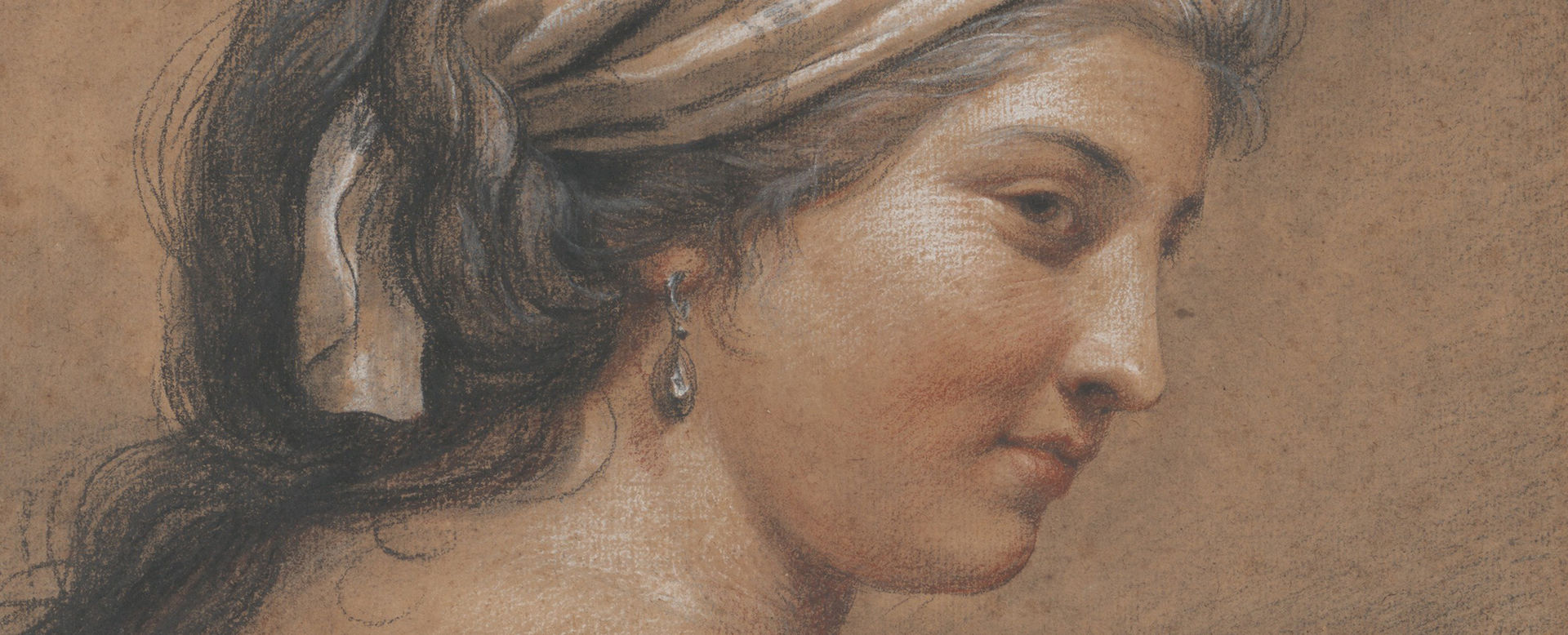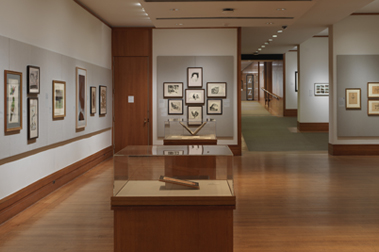Studies for Hercules Holding a Club Seen in Frontal View, Male Nude Unsheathing a Sword, and the Movements of Water (Recto); Study for Hercules Holding a Club Seen in Rear View (Verso)
Leonardo da Vinci Italian
Not on view
Discovered at auction in 2000, this sheet of sketches vividly illustrates the parallel paths of Leonardo's artistic and scientific genius. Here, the upper portion of the sheet portrays three sketches of the centrifugal swirling currents of water around obstacles, all seen from above (as if they were plans). These water sketches are very similar to motifs found in Leonardo's notebooks of ca. 1508. Immediately below is a three-quarter view of the currents by a bridge, and to the right, a sketch of a slender nude man unsheathing a sword. At bottom right is the magnificent sketch of the muscular, nude Hercules, seen from the front and holding a club horizontally. The other side of this sheet shows the same figure of Hercules, but seen from behind. The drawings of the large male figure in black chalk can be related to a mature project by Leonardo for an unexecuted sculpture of Hercules with the Nemean Lion, which he was designing at the time of his work on the full-scale drawing and mural of the Battle of Anghiari in the Palazzo Vecchio in Florence. Because this sheet represents the figure of Hercules from the front and the back, it is proof that Leonardo intended the studies for a sculpture.
----
This and three related drawings in Turin and Windsor (Biblioteca Reale inv. 15630, Turin; Biblioteca Reale inv. 15577; and RL 12625, Windsor) were exhibited together for the first time in 2003, in my attempt to reconstruct Leonardo’s ideas for a sculpture of Hercules that is otherwise unrecorded in the extant early biographies of the great master, and which was very little known to scholars until recently (see Carmen C. Bambach in Carmen C. Bambach (ed.), Leonardo da Vinci: Master Draftsman, exh. cat., The Metropolitan Museum of Art, New York, 2003, pp. 539-56, nos. 101-104). This project from Leonardo’s mature years seems mysterious in many of its details, and the double-sided sheet of sketches now in the Metropolitan Museum of Art was virtually unknown to Leonardo scholars until it was publicized in the Sotheby’s auction in 2000. The Metropolitan Museum sheet provides an important key to the puzzle of Leonardo’s Hercules sculpture. The first hypothesis that Leonardo might have considered doing a statue of this subject is due to Carlo Pedretti (Carlo Pedretti, "L'Ercole di Leonardo," L'Arte 57 (1958), pp. 163-72.Pedretti 1958b, pp. 163-70); the only existing proof had been the large study of Hercules with the Nemean Lion seen from the back in Turin (Biblioteca Reale inv. 15630).
The Hercules project seems to have evolved during the late phase of Leonardo’s work on the cartoon and mural of the Battle of Anghiari, planned for the "Sala del Gran Consiglio" in the Palazzo della Signoria of Florence in 1506-1508. Another sheet in Turin (Biblioteca Reale inv. 15577) includes two large, neatly drawn studies of a nearly identical Herculean figure seen from the back, but which was probably envisioned as a warrior for the left portion of the Battle of Anghiari, as well as a number of small sketches of soldiers and horsemen. On the upper left of the Turin sheet (inv. 15577), a more elusive design also echoes the final composition of the standing Leda, developed by Leonardo around 1508. Attentive analysis suggests that a few of Leonardo’s anatomical and proportion studies from 1506-1508 may have been inspired by the challenge of designing the Hercules project, as well, and one such example, among many others, is a study of the comparative anatomy of the legs of man and horse (RL 12625, Windsor). Although from 1506 to 1508, Leonardo moved back and forth between Florence and Milan, in the service of both the Florentine republic and the French rulers occupying the city of Milan, it is most probable that the Hercules sculpture was intended for a Florentine patron.
The Metropolitan Museum sheet, which can be dated to 1506-10, probably represents the first idea for the Hercules statue, and combines a variety of other sketches. The upper part of the recto depicts three sketches of the centrifugal swirling currents of water around obstacles, all seen from above, as if they were plans. The technique and style of these sketches are closely related to Leonardo’s experiments on the flow of water in the Codex Leicester, Collection of Bill and Melinda Gates, Seattle, Washington (Sheets 9, 13, 14, and 15), to his larger, more detailed study of water passing through obstacles and falling into a pool (RL 12660 verso, Windsor), as well as to some of the pages in the Paris Manuscript F, a notebook that he inscribed (fol. 1 recto): "Comi[n]ciato a Milano a dì 12 di sette[m]bre 1508."
About six months earlier Leonardo had been living in Florence, for he inscribed the first page of the disorderly notebook that is the Codex Arundel (British Library, London; fol., 1 recto): "Comi[n[ciato in Firenze in casa Piero di Braccio Martelli addì 22 di marzo 1508: e questo fia vn racolto sanza ordine…" The pen and ink drawing technique of the water sketches in the Metropolitan sheet and of Sheets 9, 13, 14, and 15 of the Codex Leicester is identical, showing a free, deeply tonal use of curved hatching. Immediately below in the Metropolitan sheet is a three-quarter view of the water currents flowing by a bridge, and this is also identical in treatment to some of the pages in the Codex Leicester. The sketch on the right in the Metropolitan sheet portrays a slender nude man sheathing or unsheathing a sword, and both the quick pen and ink drawing technique and the figural type seem reminiscent of the soldiers and horsemen in the very quick sketches for the unfinished Battle of Anghiari (see Gallerie dell’Accademia inv. nos. 215A, 215, 216, Venice; British Museum inv. 1886-6-9-41, London; and Biblioteca Reale inv. 15577, Turin).
Toward the bottom right on the Metropolitan sheet is the magnificent sketch of the nude, muscular Hercules seen from the front and holding a club horizontally. On the verso, the same figure of Hercules is seen from the back; these sketches are drawn with a grainy, soft black chalk or charcoal. One of Leonardo’s impassioned statements about the sculptor’s work, stated in the Paragone, as recorded in the Libro di Pittura (Codex Urbinas Latinus 1270, fol. 26 verso), can prove that he intended these sketches for a sculpture: "…dice lo scultore che no[n] po fare / una figura che non ne faccia infinite per gli infiniti / termini c’hano le quantita continue, rispondesi che’gli in/finiti termini di tal figura si riduccono in due mezze fi/gure cioe’ una mezza dal mezzo indietro et l’altra mezza / dal mezzo in anzi le quali sendo ben proportionate com/pongono una figura tonda e’queste tali mezze [figure] hauen/do li loro debiti rileui intutte le loro parti rispondera[n]no / per se sanz’altro magistero tutte l’infinite figure che tale scultore dice hauer fatte chel medesimo sipo dire a uno / che faccia un uaso al torno perche anchora si po mostra/re il suo uaso per infiniti aspetti." It is precisely such a representation of Hercules -- front and back, in "due mezze figure" – that is seen in the Metropolitan Museum sheet. And, no less significantly and again true to the spirit of Leonardo’s passage, if one holds the Metropolitan sheet up to the light, it is evident that the artist traced through the profiles of the front view onto the other side of the sheet to create the outlines determining the figure in the corresponding back view (a lucido technique). Other examples exist of Leonardo’s practice of tracing a design from one side of the sheet onto the other by holding it against the light (British Museum inv. 1856-6-21-1, London; RL 12356, Windsor).
The general manner of envisioning the pose of Hercules, front and back, is related to the exercises in figural anatomical drawing practiced by Antonio Pollaiuolo in his famous, much-copied Man Seen From Three Views (of which the best version is Musée du Louvre, Depart. des arts graphiques inv. 1486, Paris), and which Leonardo’s Hercules sketches resemble in design. What is strikingly new about Leonardo’s conception of Hercules is the tense stance of alertness. This vigilant Hercules type is quite anti-Classical in mood, for, unless Hercules is depicted as actually performing one of his twelve mythical labors, the examples from Antiquity always show the figure in repose. The iconography of Hercules was well established in Florence, particularly by the last quarter of the Quattrocento; the sculptor Bertoldo di Giovanni produced many such statuettes. (See Ettlinger 1972, pp. 119-142; and Draper 1992, pp. 146-59, nos. 12-14.)
The most famous monumental, public example of a Hercules statue, before Leonardo’s design, seems to have been Michelangelo’s lost marble of 1493-94, a Hercules that stood about 2.33 meters high (in a resting pose to judge from the surviving visual evidence), and which ended up in the collection of Francis I King of France (Leonardo’s patron from 1517 to 1519), and was installed in the gardens at Fontainebleau. (On Michelangelo’s early Hercules statue, see De Tolnay 1969, vol. 1, pp. 197-98, no. XIV; Harprath 1994, pp. 91-98; and Cox-Rearick 1996, pp. 302-13, no. IX-5.) The polychromed terracotta Hercules on the fireplace of the Sala Grande (Palazzo Gondi, Florence), executed between 1497 and 1503 for the Florentine banker Giuliano Gondi, appears to offer the most important precursor for Leonardo’s vigilant Hercules type. (See Bambach 2001, pp. 16-23; and on Giuliano da Sangallo’s Palazzo Gondi fireplace, Giancarlo Gentilini in Paola Barocchi (ed.), Il Giardino di San Marco: Maestri e compagni del giovane Michelangelo, exh. cat., Florence, Casa Buonarroti. Florence and Cinisello Balsamo (Milan), 1992, pp. 45-46, nos. 7-8.) The terracotta sculpture can be attributed to Giuliano da Sangallo, the architect of the Palazzo Gondi and the designer of the fireplace based on tradition (mentioned by Giorgio Vasari, Le vite de' più eccellenti pittori, scultori ed architettori scritte da Giorgio Vasari, pittore aretino, con nuove annotazioni e commenti di Gaetano Milanesi, Florence, 1906, vol. 4, pp. 275-76). Giuliano da Sangallo and Leonardo had been friends probably since the late 1470s while both were in Florence; Giuliano went to Milan on 13 October 1492 to present Ludovico Sforza "Il Moro" the modello for a palazzo; when Leonardo resettled in Florence in 1500-1501, both he and Giuliano were consulting architects regarding the foundations of the church of San Salvatore. Vasari’s vita of Giuliano da Sangallo states that Leonardo received advice from Giuliano about the problems of casting the Sforza equestrian monument (Vasari 1906, vol. 4, p. 276).
While much about Leonardo’s Hercules statue remains unknown, including the circumstances of its patronage, its intended final setting, and its scale, I have speculated that it was meant to be a monumental sculpture (possibly for a public setting), and have also noted that Leonardo’s reinvention of Hercules as an image of preparedness, tensely holding the club in his hand, offers an allusion to civic vigilance similar to Michelangelo’s gigantic marble David, a figure representing liberty and the Christianized Hercules, embodying physical and moral strength. According to Vasari, Piero Soderini (gonfaloniere di giustizia) had originally thought of giving the marble block for the David to Leonardo, but the story was often discredited, because it has been thought that Vasari’s account did not fit the supposed chronology of historical events. Recent research shows, however, that Soderini served in his post in the spring of 1501, and that he had been a key political player in the Florentine republic since 1500; the David was commissioned from Michelangelo on August 16, 1501. Leonardo’s small sketch of a Neptune with Sea Horses (RL 12591, Windsor) offers an inspired reworking of Michelangelo’s David in terms of the Herculean physical type that the older master had come to prefer by 1507-1508. Leonardo (as well as Giuliano da Sangallo, who was also Michelangelo’s trusted colleague) was among the artists and artisans who helped to determine the location of the colossal David on 25 January 1504, when it was decided by vote that it should be installed at the entrance of the Palazzo della Signoria, facing the Piazza della Signoria. Leonardo was also Michelangelo’s famous rival in the decoration of the "Sala del Gran Consiglio" of the Palazzo della Signoria from 1503 to 1508. As I have suggested, considering the charged professional interaction between the two great artists during these years, it is worth speculating that Leonardo conceived of his Hercules sculpture with a civic function in mind, and in competition with Michelangelo.
Documents demonstrate that Michelangelo was working on his own ideas for a Hercules statue around 1506 (even going as far as roughing out a sketch for the intended marble block), and that this colossal figure was conceived of as a pendant to the newly installed David. But nothing seems to have come of this project, and at a much later date, from 1525 to 1534, Baccio Bandinelli would plan and produce a Hercules group for the site, and it would be reviled by some of his contemporaries for its weaknesses of design in comparison to Michelangelo’s heroic David. Vasari’s vita of Baccio Bandinelli (1488-1560) offers two insights regarding his connection to Leonardo, and which may suggest that he was possibly aware of Leonardo’s ideas for a Hercules statue around 1508 (Vasari 1906, vol. 4, pp. 136-37, 138). According to Vasari, Bandinelli was trained by the sculptor Giovanni Francesco Rustici (1474-1554), who was Leonardo’s close associate and friend, and when Bandinelli was still a young apprentice to Rustici, his drawings were favorably assessed by Leonardo himself: this would have probably occurred around 1504-1508. Also according to Vasari (but stated in a somewhat contradictory account), Bandinelli was accused by some of his contemporaries of causing the destruction of Michelangelo’s famous Battle of Cascina cartoon, out of his affection for Leonardo. The Hercules figure sketched in the Metropolitan sheet receives a more defined context, with the addition of the Nemean lion at the hero’s feet, in the large working drawing in Turin (Biblioteca Reale inv. 15630).
(Carmen C. Bambach)
This image cannot be enlarged, viewed at full screen, or downloaded.
This artwork is meant to be viewed from right to left. Scroll left to view more.
